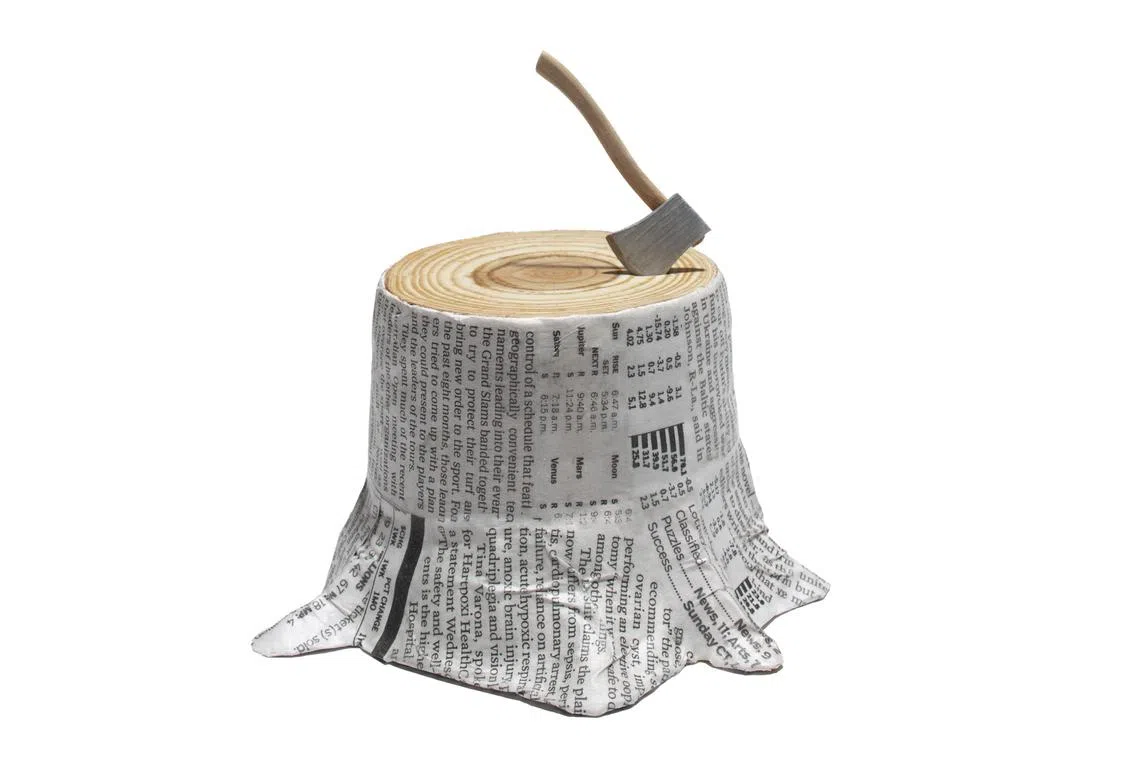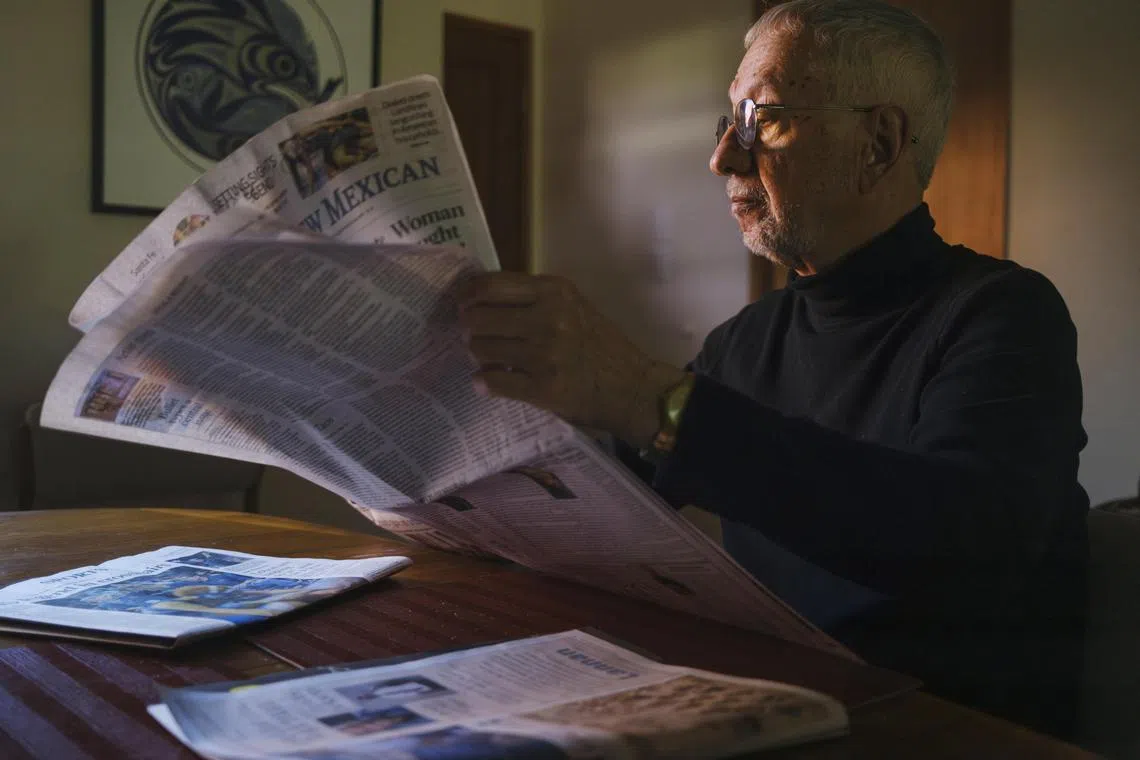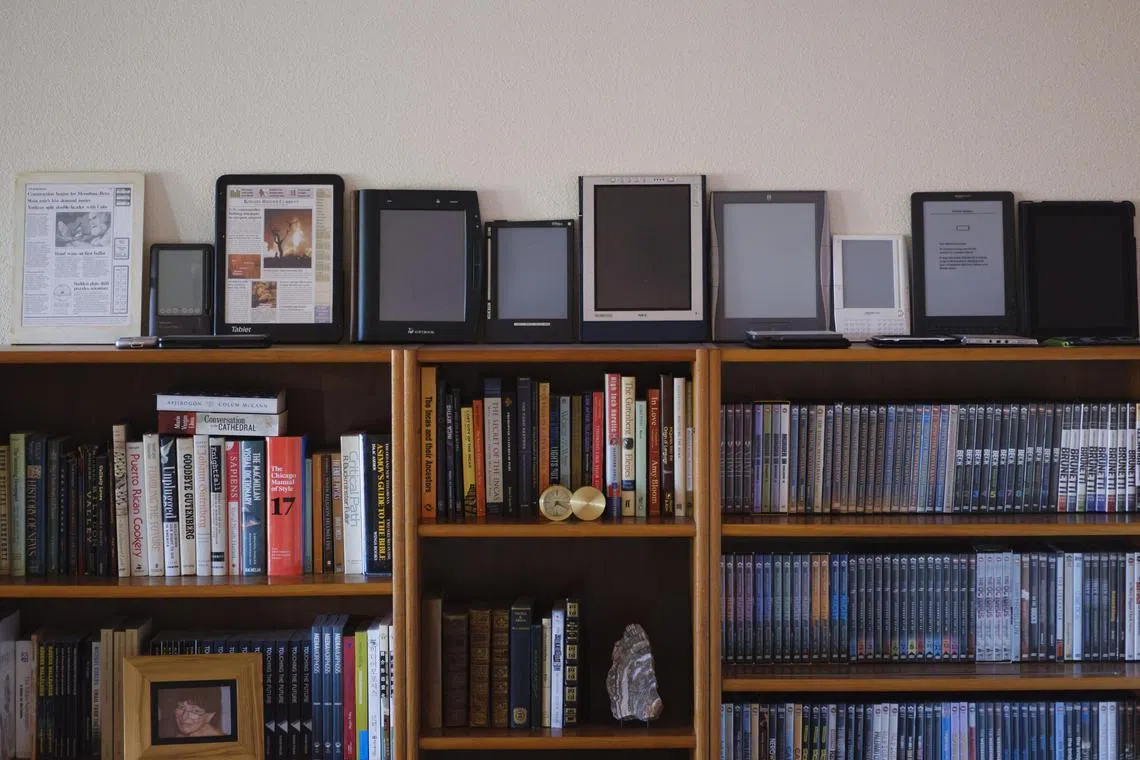How the media industry keeps losing the future
Sign up now: Get ST's newsletters delivered to your inbox

The collapse of traditional media seems to be accelerating.
PHOTO: NYTIMES
Follow topic:
SAN FRANCISCO – If the career of Mr Roger Fidler has any meaning, it is this: Sometimes, you can see the future coming but get trampled by it anyway.
Thirty years ago, Mr Fidler was a media executive pushing a reassuring vision of the future of newspapers.
The digital revolution would liberate news from printing presses, giving people portable devices that kept them informed all day long. Some stories would be enhanced by video, others by sound and animation.
Readers could share articles, driving engagement across diverse communities.
All that has come to pass, more or less. Everyone is online all the time, and just about everyone seems interested, if not obsessed, by national and world happenings.
But the traditional media that Mr Fidler was championing does not receive much benefit. After decades of decline, their collapse seems to be accelerating.
Every day brings bad news. Sometimes it is about recently formed digital enterprises, sometimes venerable publications whose history stretches back more than a century.
Cutbacks were just announced at Law360, The Intercept and the youth-oriented video site NowThis, which laid off half its staff.
The tech news site Engadget, which comprehensively tracks tech layoffs, laid off its top editors and other staff members. Conde Nast and Time are shedding employees.
The continued existence of Vice Media, once valued at US$5.7 billion (S$7.66 billion), and Sports Illustrated, in another era the most influential sports publication, is uncertain.
The Los Angeles Times and The Washington Post eliminated hundreds of journalists between them. One out of four newspapers that existed in 2005 no longer does.
The slow crash of newspapers and magazines would be of limited interest, save for one thing: Traditional media had at its core the exalted and difficult mission of communicating information about the world.
From investigative reports on government to coverage of local politicians, the news served to make all the institutions and individuals covered a bit more transparent and, possibly, more honest.

Mr Roger Fidler, who spent 21 years at the Knight Ridder newspaper chain and helped develop technology for lightweight tablets that would use low cost flat-panel displays for subscribers to view news stories.
PHOTO: NYTIMES
The advice columns, movie reviews, recipes, stock data, weather report and just about everything else in newspapers moved easily online – except the news itself.
Local and regional coverage had a hard time establishing itself as a paying proposition.
Now there are signs that the whole concept of “news” is fading. Asked where they get their local news, nearly as many respondents to a Gallup poll said social media as those who mentioned newspapers and magazines.
A recent attempt to give people free subscriptions to their local papers in Pennsylvania as part of an academic study drew almost no takers.
“Soon after the printing press emerged in the 15th century, the scriptoriums for copying manuscripts in monasteries rapidly began shutting down,” said Mr Fidler, now 81 and living in retirement in Santa Fe, New Mexico.
“I’m not very optimistic about the survival of the majority of newspapers in the United States.”
Decline and flail

Mr Roger Fidler at the Columbia School of Journalism in New York, June 19, 1992.
PHOTO: NYTIMES
The decline of the news media has been paralleled by the fracturing of US society, which is now as angry and divided as it has been since the height of the Vietnam War and civil rights protests more than a half-century ago. As the media fell, the noise level rose.
Perhaps it could have been different. Contrary to the myth that all the newspaper magnates of the 1980s and 1990s thought the good times would last forever, quite a few saw trouble lurking in the far distance.
Mr Fidler spent 21 years at Knight Ridder, a newspaper chain that had important metro dailies in cities like Miami, Florida, and San Jose, California.
One early project was Viewtron, an effort to put terminals in people’s homes that would deliver news, shopping and chat. It delivered too little and cost too much. In 1986, Viewtron was shut down.
What Mr Fidler took away from Viewtron’s failure was that newspaper readers needed something that looked like a newspaper and that did not pinch them in the wallet.
Mr Fidler then helped to develop technology for lightweight tablets that would use flat-panel displays that were low cost but clear and bright with a relatively long battery life.
Such displays did not exist in the early 1990s but were promised by the end of the decade.
The newspaper would be transmitted through high-speed digital telephone networks or direct broadcast satellite transmissions.
“I think this will be the salvation for the traditional serious newspapers,” Mr Thomas Winship, a long-time editor of The Boston Globe, told The New York Times in a 1992 profile of Fidler.
While at least some publishers were convinced, the tablets never came to save newspapers.

Early tablet designs at the home of Mr Roger Fidler.
PHOTO: NYTIMES
One problem was there was no consensus on a software standard. Tablets did not really become viable until Apple introduced the iPad in 2010. But the real problem for the news business was the emergence of a devastating and unforeseen competitor: the Internet.
“I was too narrowly focused,” Mr Fidler conceded.
The Internet would first create an alternative to printed newspapers and magazines, then become a competitor, and finally annihilate many of them.
“I didn’t consider all the possible cross impacts of emerging technologies that would lead to Craigslist, alternative news sites, social media and other products that would greatly diminish newspaper circulation and advertising revenue,” Mr Fidler said.
Mr Tim Berners-Lee created the World Wide Web in 1989 as a tool for collaborating and for sharing information.
Being amorphous and infinitely flexible, it allowed for slow adapters and fast adapters at the same time, which circumvented the sort of hand-holding for readers that Mr Fidler believed necessary.
Newspapers lost their classified ads to the Internet almost immediately. The display ads lingered, but Google and Facebook, and later Amazon, took over that market.
The Web, by essentially allowing every voice to be heard at the same volume, encouraged publishers to join the party. Newspapers and magazines simply gave away what they had charged for in physical form. They were pushed by Silicon Valley, which needed quality content to keep people online and using its technology.
“Publishers got this mistaken belief that content is like a commodity and should be available everywhere for free,” Mr Fidler said. It took years to institute paywalls, by which point many publications were fatally weakened.
Good old days weren’t that good

The Internet would first create an alternative to printed newspapers and magazines, then become a competitor, and finally annihilate many of them.
PHOTO: NYTIMES
For all the gloom that the media is wallowing in about the media, the situation is contradictory.
Reliable local reporting in many places is sparse or non-existent.
But there is also a much wider variety of foreign, national and cultural news available online than previous generations could get in print. For all the celebration of the old days, if you were in a city with a mediocre newspaper – and there were many – access to quality journalism was difficult.
“Basically, the world has been opened up to us. There’s so much good journalism out there,” said journalism professor David Mindich from the Klein College of Media and Communication at Temple University.
“If you had said to me 20 years ago, ‘I see a generation listening to long-form audio shows,’ I would have said, ‘Attention spans are getting shorter. I don’t think that’s going to happen.’ But it did.”
Most long-form audio shows, even at their best, are not news in the way, say, a zoning commission report is news. The erosion of the idea of news can be seen even more vividly in the magazine field. Where the goal was to inform, now it is to entertain.
“Time magazine just selected Taylor Swift as the person of the year,” said Dr Samir Husni, a long-time magazine analyst.
“It never selected Elvis or the Beatles. She was the first entertainer. We’re becoming more about marketing in journalism than truth in journalism because we’re depending on the customer to pay the price rather than advertising.”
This is how digital has changed journalism, he said, adding: “The thing now is to make everybody happy. But that was never the role of journalism, making people happy.”
Mr Marc Benioff, the Silicon Valley entrepreneur who bought the struggling Time in 2018 with his wife Lynne, viewed the selection of Swift differently: “Best-selling issue of all time!” (In recent years, at least.)
A few weeks after the Swift issue appeared, Time’s union said 15 per cent of the magazine’s unionised editorial staff got the axe.
That was more of a strategic move than a sign of distress, Mr Benioff said.
“If you’re going to make these media businesses work, you have to shift the product mix, which also means you have to shift the employee mix,” he texted.
The paywall, put in place in 2011, was dropped in 2023. As a brand, Time needs the widest exposure possible.
Two years ago, Mr Benioff told Axios that Time’s revenue would be up 30 per cent in 2022 to US$200 million. That might have been aspirational.
“Revenue in 2024 should hit US$200 million, a new high,” he says now. “We’re even going to make money.”
Other publications are trying to take the profit motive out of journalism.
Non-profit news ventures tend to be small, low profile and unevenly distributed across regions. But there are many signs of growth. The number of outfits serving communities of colour – never very well served by traditional publications – has doubled in the past five years, according to the Institute for Non-profit News.
Readers generally respond, too.
“People talk about non-profit reporting in their communities like it’s a normal part of the news ecosystem, not like it’s some outside force,” said Associate Professor Magda Konieczna, author of Journalism Without Profit: Making News When The Market Fails.
In some places, the effect is striking. “Philadelphia is now a news jungle rather than a news desert,” she said.
Prof Konieczna teaches at Concordia University in Montreal. A few weeks ago, a Canadian news giant, Bell Media, announced that it was cutting hundreds of jobs and ending many of its television newscasts.
Prime Minister Justin Trudeau said the decision was “eroding our very democracy”.
Prof Konieczna said: “My neighbours read The New Yorker but don’t know where to find local news, or why they would want to, in large part because it doesn’t really exist.
“This is the dystopian future.”
The New Yorker, as it happened, employed Mr A.J. Liebling, the greatest press critic of the post-war years. He called himself an optimist, despite seeing a downhill march ever since he became a reporter in 1925.
“The function of the press in society is to inform, but its role is to make money,” he wrote. The more it did the latter, he argued, the less it bothered with the former.
There was no golden age, but Mr Roger Fidler is still inconsolable.
He long ago outlasted Knight Ridder, which was sold to McClatchy, another chain, in 2006.
McClatchy declared bankruptcy in 2020.
Mr Fidler spends a couple of hours each day reading the news in the printed edition of a community newspaper and the digital editions of national and regional newspapers. It is a lot, and yet not enough.
“Social media and its comments overwhelmed us,” he said.
“We’re flooded with information because everybody’s a journalist. Everyone thinks they have the truth. Everyone certainly has an opinion. It’s discouraging to see how it’s gone.” NYTIMES

